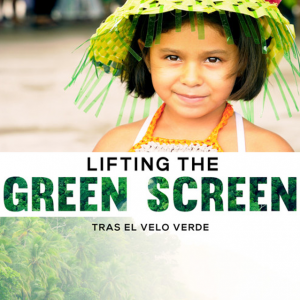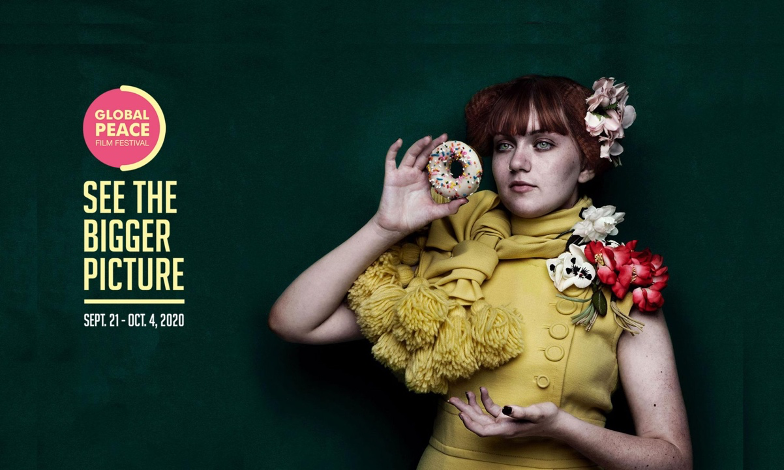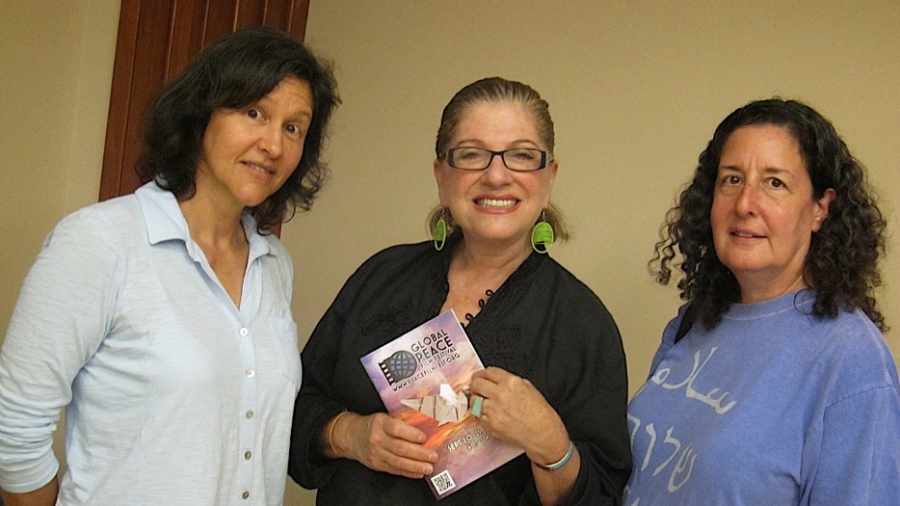Film Fest Magazine writer Jonah Azurin interviews Executive Director Nina Streich and Artistic Director/Programmer Kelly DeVine as they discuss GPFF’s robust virtual programming, their community and audience engagement.
[Pictured above: Kelly DeVine, Filmmaker Tami Gold, and Nina Streich]Can you tell us about how GPFF got started?
Nina: This is actually our 18th year. The first year was 2003 and the motivation behind creating the festival was the start of and in response to the Iraq war. When I was hired to create GPFF, I didn’t want to do something that was centered around or against the war. I wanted to create a festival that showed a positive vision of peace and a festival where rather than seeing films and then going home, the films programed inspired people. Kelly came on board in 2006 as the Artistic Director and has been the Artistic Director and Programmer since then.
Kelly: I was very much interested in that mission. I had just left a job being a buyer for the Independent Film Channel and I wanted to reconnect with the power of storytelling in order to change and touch people’s lives. When you are a buyer for television, it’s wonderful but you don’t have that kind of connection with the people who engage with the work that you’ve done. I really wanted to curate work for people rather than curating work largely for marketing opportunities. Nina does this amazing job of establishing these relationships and keeping her finger on the pulse of what is going on in Orlando and she and I are in constant communication about that pulse. That’s what helps and guides me in order to program in a way so that we’re really serving this community.
How have you kept your audience engaged during the times of COVID-19?
Nina: Kelly and I immediately started thinking about what we could do now. We can’t bury our heads in the sand. Some of the small distributors were opening up almost their entire libraries while people were sort of stuck inside and we saw work by filmmakers whose films had played in previous festivals. We decided to direct our audiences to go watch those films while they were available and then on a certain date and time, come to a Zoom Q&A.
Kelly: We tried that for the first couple of sessions, but we found that merely translating what you would do in an in-person event online didn’t really reckon with how people’s behavior is different online than in-person. Instead, we looked at the medium and thought about what we could do. Rather, we tried to do something that meets the medium of being online, that involved having an interview with a filmmaker. The audience was in the offing but there wasn’t any live interaction, so we had a really lovely, short, succinct interview using Zoom. Filmmakers had the chance to answer questions they had wanted to [address]. In one case, there was a participant in the research of a particular film who was integral to the process, but their on-camera interviews never made it into the documentary. Here was this chance to honor that person and to bring her into this conversation in a way that wouldn’t have happened otherwise. We really opened it up to serve the filmmakers and figure out what we can do to support them in this moment. And of course, at the end, we heard from all of the folks who were listening via Facebook or getting in touch with us afterwards by email and other means saying, “I can’t wait to see this film”. It did exactly what we had hoped.
Nina really came up with some very innovative ways to engineer some in-person events in partnership with our community partners, specifically museums because [they] had already adapted to metering people and social distancing. Then, we incorporated some film element into that so we could have some in-person events Those events really were shaped so that they kept everyone’s safety paramount while also providing that kind of support and uplift our partners.
Nina: These partner collaborations created an added value for the museums who are struggling to help draw audiences to them. For instance, we’re showing a film from a previous GPFF in the Orlando Science Center and the film is about the Florida Springs and aquifers. The theme for the museum that month is ‘Aquatic Adventure’ so the film actually ties in with museum’s overall programming. And we have another film at the Orlando Museum of Art which they were thrilled about because it sort of fits with an exhibit they have coming in. It’s going to provide people who go to the museum with one more thing to look in on.

Poster for Lifting the Green Screen
In regard to the content for your film festival, how do you go about selecting films?
Kelly: Well, our festival is always curated based on these kinds of relationships we’ve been discussing and the needs of our community partners. We would always leave a certain amount of room in our program to bring in outside issues and ideas. This year our selection process was hampered by the fact that filmmakers themselves had to think long and hard about what was right for them. There are filmmakers with whom I’ve had long-running talks about documentaries – films that have been years in the making – who are weighing their options. A number of them have told me that they’re just going to wait it out until next year. We’ve certainly had filmmakers who have said, “Now is just as good a time as any.”
I think our submissions were down a bit and I think you see that across the board, even with major market festivals. No one really knew what online festival exhibition was going to mean in terms of the interpretation of Video On Demand rights and impacting their value to distributors. People are attracted to our film festival for our community engagement and our emphasis for generating impact and incorporating calls to action. Regardless of the pandemic and regardless of the format, [filmmakers] were confident in the conversations they were having with us [and the fact that] we were still keeping to our mission and finding ways to present their impact plans; and to make sure that their work was fitted into a context that uplifted and supported the non-industry related reasons why they made the film.
Nina: Then the next thing was the selection of a platform. Last year we used Eventive for our ticketing. That was something that gave some of the smaller distributors and sales agents more confidence because the rights of their filmmakers would be protected.
Kelly: Since the folks behind Eventive are film festival people themselves, they recognize that a successful film festival is mounted on three equal pillars: audience, filmmakers, and film festival infrastructures. [Eventive] knew all three of those had to work well together, but [that they] also had to be respectful of each of those groups.
You can look at all of this as a big problem or a hindrance, or you can reset your mind and say, “I’m going to look at this as a challenge to see how I can still do the best work and serve people to the fullest”. I think that’s how we’ve viewed this whole process.
To learn more about GPFF and their festival that begins on Sept. 21 to Oct. 4, 2020, visit https://peacefilmfest.org/


